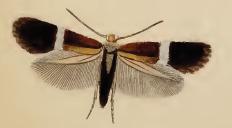| Stigmella alnetella | |
|---|---|
 | |
 | |
| Scientific classification | |
| Kingdom: | Animalia |
| Phylum: | Arthropoda |
| Class: | Insecta |
| Order: | Lepidoptera |
| Family: | Nepticulidae |
| Genus: | Stigmella |
| Species: | S. alnetella |
| Binomial name | |
| Stigmella alnetella (Stainton, 1856) | |
| Synonyms | |
| |
Stigmella alnetella is a moth of the family Nepticulidae. It is found in all of Europe, except the Balkan Peninsula.
The wingspan is 3.9-4.8 mm. The head is orange, the collar deep bronze-fuscous. The antennal eyecaps are white. The forewings are golden brown, becoming lighter golden towards the dorsum anteriorly. A bright shining silvery fascia beyond middle is preceded by a dark purplish-fuscous suffusion,the apical area beyond this is dark purplish fuscous. The hindwings are grey. [1] [2] [3] [4]
The larvae feed on Alnus cordata and Alnus glutinosa . They mine the leaves of their host plant. There is usually only one mine in a leaf. Pupation takes place outside of the mine.